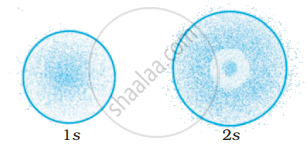Advertisements
Advertisements
प्रश्न
Define the term Electronic configuration
उत्तर
Electronic configuration of an atom is defined as the distribution of its electrons in orbitals.
APPEARS IN
संबंधित प्रश्न
Using s, p, d notations, describe the orbital with the following quantum numbers n = 1, l = 0.
Using s, p, d notations, describe the orbital with the following quantum numbers n = 4; l = 2.
Choose the correct option.
p-orbitals are _________ in shape.
State and explain Pauli’s exclusion principle.
State the order of filling atomic orbitals following Aufbau principle.
Write condensed orbital notation of electronic configuration of the following element:
Lithium (Z = 3)
Write condensed orbital notation of electronic configuration of the following element:
Carbon (Z = 6)
Write condensed orbital notation of electronic configuration of the following element:
Oxygen (Z = 8)
Write condensed orbital notation of electronic configuration of the following element:
Silicon (Z = 14)
Explain in brief, the significance of the azimuthal quantum number.
If n = 3, what are the quantum number l and m?
The principal quantum number (n) and magnetic quantum number (ml) for the valence electrons of rubidium atom (Z = 37) are ____________ respectively.
Which one of the following orders is CORRECT in case of energy of the given subshells?
P: n = 4; l = 3
Q: n = 5; I = 1
R: n = 5; l = 0
S: n = 4; l = 2
How many electrons in 19K have n = 3, l = 1?
The three electrons have the following set of quantum numbers:
X = 6, 1, −1, `+1/2`
Y = 6, 0, 0, `+1/2`
Z = 5, 1, 0, `+1/2`
Identify the CORRECT statement.
Which of the following options does not represent ground state electronic configuration of an atom?
The probability density plots of 1s and 2s orbitals are given in Figure:

The density of dots in a region represents the probability density of finding electrons in the region.
On the basis of above diagram which of the following statements is incorrect?
The number of radial nodes for 3p orbital is ______.
Number of angular nodes for 4d orbital is ______.
The pair of ions having same electronic configuration is ______.
Which of the following sets of quantum numbers are correct?
| `n` | `l` | `m_l` | |
| (i) | 1 | 1 | +2 |
| (ii) | 2 | 1 | +1 |
| (iii) | 3 | 2 | –2 |
| (iv) | 3 | 4 | –2 |
Which of the following statements concerning the quantum numbers are correct?
(i) Angular quantum number determines the three dimensional shape of the orbital.
(ii) The principal quantum number determines the orientation and energy of the orbital.
(iii) Magnetic quantum number determines the size of the orbital.
(iv) Spin quantum number of an electron determines the orientation of the spin of electron relative to the chosen axis.
The arrangement of orbitals on the basis of energy is based upon their (n + l) value. Lower the value of (n + l), lower is the energy. For orbitals having same values of (n + l), the orbital with lower value of n will have lower energy.
Based upon the above information, arrange the following orbitals in the increasing order of energy.
1s, 2s, 3s, 2p
The arrangement of orbitals on the basis of energy is based upon their (n + l) value. Lower the value of (n + l), lower is the energy. For orbitals having same values of (n + l), the orbital with lower value of n will have lower energy.
Based upon the above information, solve the questions given below:
Which of the following orbitals has the lowest energy?
4d, 4f, 5s, 5p
What is the difference between the terms orbit and orbital?
Match the following species with their corresponding ground state electronic configuration.
| Atom / Ion | Electronic configuration |
| (i) \[\ce{Cu}\] | (a) 1s2 2s2 2p6 3s2 3p6 3d10 |
| (ii) \[\ce{Cu^{2+}}\] | (b) 1s2 2s2 2p6 3s2 3p6 3d10 4s2 |
| (iii) \[\ce{Zn^{2+}}\] | (c) 1s2 2s2 2p6 3s2 3p6 3d10 4s1 |
| (iv) \[\ce{Cr^{3+}}\] | (d) 1s2 2s2 2p6 3s2 3p6 3d9 |
| (e) 1s2 2s2 2p6 3s2 3p6 3d3 |
Which of the following is not the permissible arrangement of electrons in an atom?
In assigning R - S configuration, which among the following groups has highest priority?
